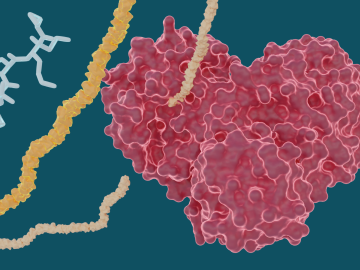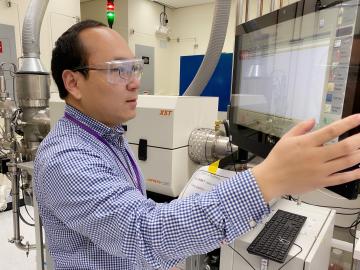
Filter News
Area of Research
- (-) Materials (61)
- (-) Neutron Science (21)
- (-) Supercomputing (41)
- Advanced Manufacturing (4)
- Biology and Environment (27)
- Computational Biology (1)
- Computer Science (1)
- Energy Science (40)
- Fuel Cycle Science and Technology (1)
- Fusion and Fission (30)
- Fusion Energy (10)
- Isotope Development and Production (1)
- Isotopes (27)
- Materials for Computing (8)
- National Security (32)
- Nuclear Science and Technology (39)
- Nuclear Systems Modeling, Simulation and Validation (1)
- Quantum information Science (4)
- Sensors and Controls (1)
News Topics
- (-) Coronavirus (22)
- (-) Cybersecurity (9)
- (-) Isotopes (14)
- (-) Microscopy (29)
- (-) Nuclear Energy (22)
- (-) Security (7)
- (-) Space Exploration (7)
- 3-D Printing/Advanced Manufacturing (30)
- Advanced Reactors (6)
- Artificial Intelligence (41)
- Big Data (23)
- Bioenergy (22)
- Biology (19)
- Biomedical (33)
- Biotechnology (2)
- Buildings (8)
- Chemical Sciences (34)
- Clean Water (4)
- Composites (9)
- Computer Science (101)
- Critical Materials (15)
- Energy Storage (41)
- Environment (40)
- Exascale Computing (26)
- Fossil Energy (1)
- Frontier (33)
- Fusion (9)
- Grid (9)
- High-Performance Computing (46)
- Hydropower (1)
- Irradiation (1)
- ITER (1)
- Machine Learning (17)
- Materials (86)
- Materials Science (90)
- Mathematics (2)
- Molten Salt (3)
- Nanotechnology (46)
- National Security (8)
- Neutron Science (129)
- Partnerships (11)
- Physics (36)
- Polymers (19)
- Quantum Computing (21)
- Quantum Science (36)
- Simulation (16)
- Software (1)
- Summit (43)
- Transportation (23)
Media Contacts

Experiments led by researchers at ORNL have determined that several hepatitis C drugs can inhibit the SARS-CoV-2 main protease, a crucial protein enzyme that enables the novel coronavirus to reproduce.

To better understand how the novel coronavirus behaves and how it can be stopped, scientists have completed a three-dimensional map that reveals the location of every atom in an enzyme molecule critical to SARS-CoV-2 reproduction.

About 60 years ago, scientists discovered that a certain rare earth metal-hydrogen mixture, yttrium, could be the ideal moderator to go inside small, gas-cooled nuclear reactors.

Researchers at ORNL used quantum optics to advance state-of-the-art microscopy and illuminate a path to detecting material properties with greater sensitivity than is possible with traditional tools.

A team led by Dan Jacobson of Oak Ridge National Laboratory used the Summit supercomputer at ORNL to analyze genes from cells in the lung fluid of nine COVID-19 patients compared with 40 control patients.

From materials science and earth system modeling to quantum information science and cybersecurity, experts in many fields run simulations and conduct experiments to collect the abundance of data necessary for scientific progress.

Five researchers at the Department of Energy’s Oak Ridge National Laboratory have been named ORNL Corporate Fellows in recognition of significant career accomplishments and continued leadership in their scientific fields.

Oak Ridge National Laboratory researchers have built a novel microscope that provides a “chemical lens” for viewing biological systems including cell membranes and biofilms.

A team of researchers has performed the first room-temperature X-ray measurements on the SARS-CoV-2 main protease — the enzyme that enables the virus to reproduce.

In the search to create materials that can withstand extreme radiation, Yanwen Zhang, a researcher at the Department of Energy’s Oak Ridge National Laboratory, says that materials scientists must think outside the box.


